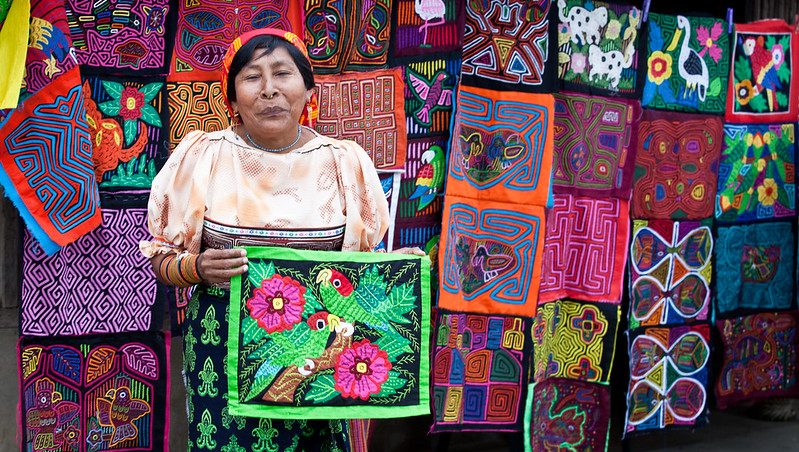If you are traveling to a Spanish-speaking country, you’ll eventually need to do some shopping. While you might be able to get by without needing much Spanish if you stick to major retail stores, its helpful to know a few key words and phrases before you venture into the more local shops.
Here’s a lesson taken from our Spanish Headstart course that will help you learn all you need to know to purchase souvenirs or other goods in stores.
After you complete this lesson, you’ll know everything you need in order to ask about questions about common items, and even negotiate prices like a native speaker.
In the following scenario, Bob decides to do a little souvenir shopping during a visit to Panama City and stops at an outdoor market that is selling a variety of souvenirs.
Press play on the audio below to listen to the conversation, and use the written transcript to follow along below.
Bob:
How much do you want for that mola?
¿Cuánto quiere por esa mola?
Seller:
Twenty-five Balboas, sir.
Veinticinco Balboas, señor.
twenty-five veinticinco
Bob:
Why so expensive?
¿Por qué tan cara?
why por qué
so tan
Seller:
Because it’s of very good quality.
Porque es muy fina.
because porque
good quality fina
Bob:
Won’t you let me have it for twenty dollars?
¿No me la deja en veinte dólares?
let (to let) deja (dejar)
Seller:
Not for twenty, but I’ll let you have it for twenty-two.
En veinte no, pero se la dejo en veintidós.
twenty veinte
twenty-two veintidós
Bob:
OK. And that ashtray, what is it made of?
Está bien. Y ese cenicero, ¿de qué está hecho?
ashtray cenicero
made hecho (hacer)
Seller:
Out of soapstone, sir.
De piedra de jabón, señor.
rock, stone piedra
soap jabón
soapstone piedra de jabón
Bob:
How much do you want for it?
¿Cuánto quiere por él?
Seller:
Only two fifty.
Dos cincuenta solamente.
Bob:
Won’t you give me a little discount?
¿No me hace una rebajita?
small discount rebajita
Seller:
Well, I’ll let you have it for two.
Bueno, se lo dejo en dos.
Bob:
OK.
Está bien.
Lesson Notes:
- The Mola is a hand-made textile that forms part of the traditional women’s clothing of the Cuna people – one of most visible of the indigenous peoples of Panama. The mola forms part of the traditional outfit of a Cuna woman, with two mola panels being incorporated as front and back panels in a blouse.The mola consists of of several layers of brightly colored cotton cloth. The layers are stitched together, and carefully cutout designs expose the underlying colors.The decorative panels are made into blouses and worn as everyday attire by the Cuna women. Molas are also popular wall hangings.
- Piedra de jabón, literally “stone of soap,” is abundant in Panama. Artisans carve it with penknives to make ashtrays, bookends, figurines, and other small items. This stone is easily broken and so soft that it dissolves in water.
- ¿Cuánto quiere? How much do you want for it? is not used in markets where the prices are fixed.
- Se (“to you”) is used instead of le when the next word is lo or la.
- Por él means “for it” when “it” refers to masculine singular words, for example, cenicero. If Bob had been referring to a mola, he would have said, ¿Cuánto quiere por ella?, “How much do you want for it?”
Quick Review:
- What’s the difference between ¿por qué? and porque?
- How do you say each of the following:
- How much do you want for it (masculine)?
- Wont you give me a small discount?
Want access to more practical Spanish lessons like this? Check out Spanish Headstart or our flagship One Month Spanish course.
Photo credit: Ben Kucinski, Creative Commons.


